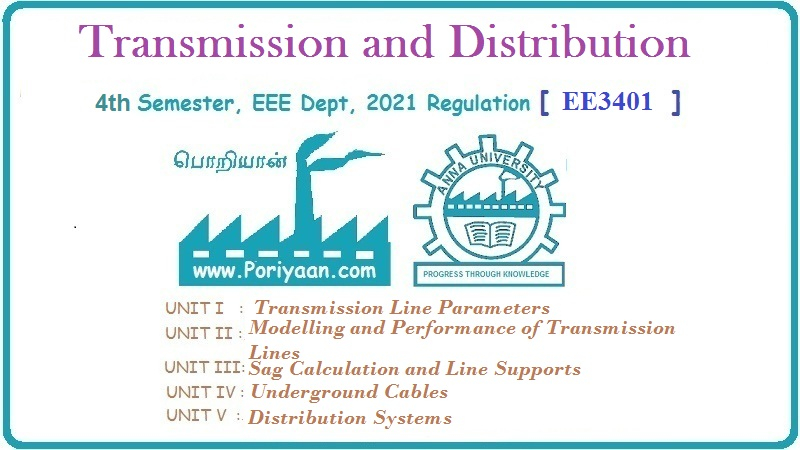Transmission and Distribution: Unit IV: Underground Cables
Insulation Resistance of a Cable
Underground Cables
Questions : 1. Derive an expression for insulation resistance of a cable 2. A single core cable has a conductor diameter of 1 cm and insulation thickness cf 0.5 cm. If the specific resistance of an insulation is 5 × 1014 Ω cm. Calculate the insulation resistance for 3 km length of the cable.
Insulation Resistance of a
Cable
The Fig. 6.6.1 shows the section of a
single core cable which is insulated with the help of layer of an insulating
material.
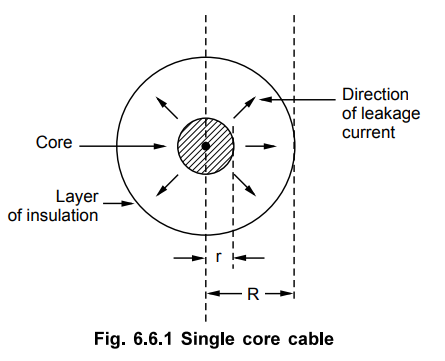
In such cables, the leakage current
flows radially from centre towards the surface as shown in the Fig. 6.6.1.
Hence the cross-section of the path of such current is not constant but changes
with its length. The resistance offered by cable to path of the leakage current
is called an insulation resistance. So to calculate the insulation resistance
consider an elementary section of the cylindrical cable of radius x and the thickness dx as shown in the Fig.
6.6.2. Let us find the resistance of this elementary ring.
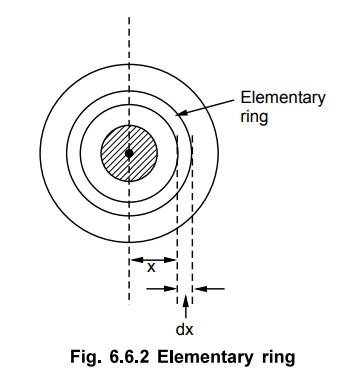
Let d = Diameter of core
r = d / 2 = Radius of core
D = Diameter with sheath
R = D / 2 = Radius of cable with sheath
As the leakage current flows radially
outwards, the length along which the current flows in an elementary ring is dx.
While the cross-sectional area perpendicular to the flow of current depends on
the length I of the cable.
Cross-section area = Surface area for
length l of cable
=
(2πx) × l
Hence the resistance of this elementary
cylindrical shell is,
dRi = ρ . dx / 2πx l ... as R = ρl / A
where p = Resistivity of the insulating
material
The total insulation resistance of the
cable can be obtained by integrating the resistance of an elementary ring from
inner radius upto the outer radius i.e. r to R.
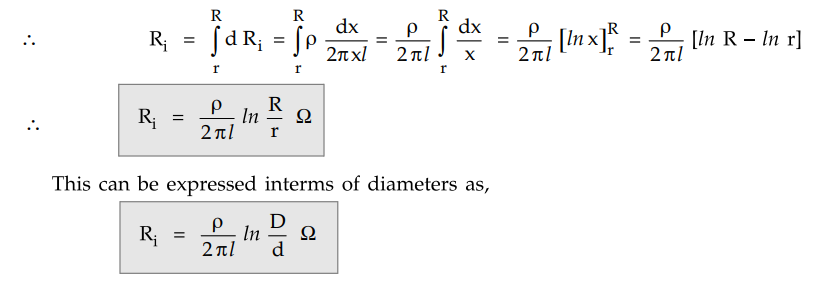
The value of Ri is always
very high. The expression shows that the insulation resistance is inversely
proportional to its length. So as the cable length increases, the insulation
resistance decreases.
This shows that if two cables are joined
in series then total length increases and hence their conductor resistances are
in series giving higher resistance but their insulation resistances are in
parallel decreasing the effective insulation resistance. Thus if two cables are
connected in parallel, conductor resistances get connected in parallel while
the insulation resistances get connected in series.
Example 6.6.1
Two underground cables A and B, each has a conductor resistance of 0.6 Ω and
0.8 Ω respectively while each fas on insulation resistance of 600 M Ω
and 400 M Ω respectively. If the cables are connected in,
a) Series and b) Parallel, calculate the effective conductor and insulation
resistance in each case.
Solution :
a) Cables are in series
When cables are in series, conductor
resistances are in series while insulation resistances are in parallel.
Effective conductor resistance = 0.6 +
0.8 = 1.4 Ω
and Effective insulation resistance =
600 MΩ || 400 MΩ
600 × 400 / 600 + 400 = 240 MΩ
In series, length increases and insulation
resistance is inversely proportional to length hence effective insulation
resistance value decreases.
b) Cables are in parallel
In this case, the conductor resistances
are in parallel while the insulation resistances are in series.
Effective conductor resistance = 0.6 ||
0.8
= 0.6 × 0.8 / 0.6 + 0.8 = 0.3428 Ω
Effective insulation resistance = 600 M
Ω
+ 400 M Ω
= 1000 M Ω
Example 6.6.2
A single core cable has a conductor diameter of 1 cm and insulation
thickness of 0.4 cm. The specific resistance of the insulation is 5 × 1014
Ω cm. Calculate the insulation resistance for a 2 km length of cable.
Solution : d
= 1 cm, insulation thickness = 0.4 cm, ρ = 5 × 1014 Ω cm
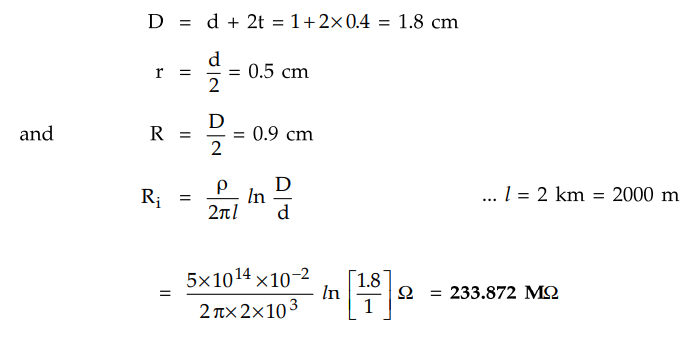
Review Questions
1. Derive an expression for insulation resistance of a
cable.
2. A single core cable has a conductor diameter of 1 cm and
insulation thickness cf 0.5 cm. If the specific resistance of an insulation is 5
× 1014 Ω cm. Calculate the insulation resistance for 3 km
length of the cable.
[Ans.: 183.86 M Ω]
Transmission and Distribution: Unit IV: Underground Cables : Tag: : Underground Cables - Insulation Resistance of a Cable
Related Topics
Related Subjects
Transmission and Distribution
EE3401 TD 4th Semester EEE Dept | 2021 Regulation | 4th Semester EEE Dept 2021 Regulation
